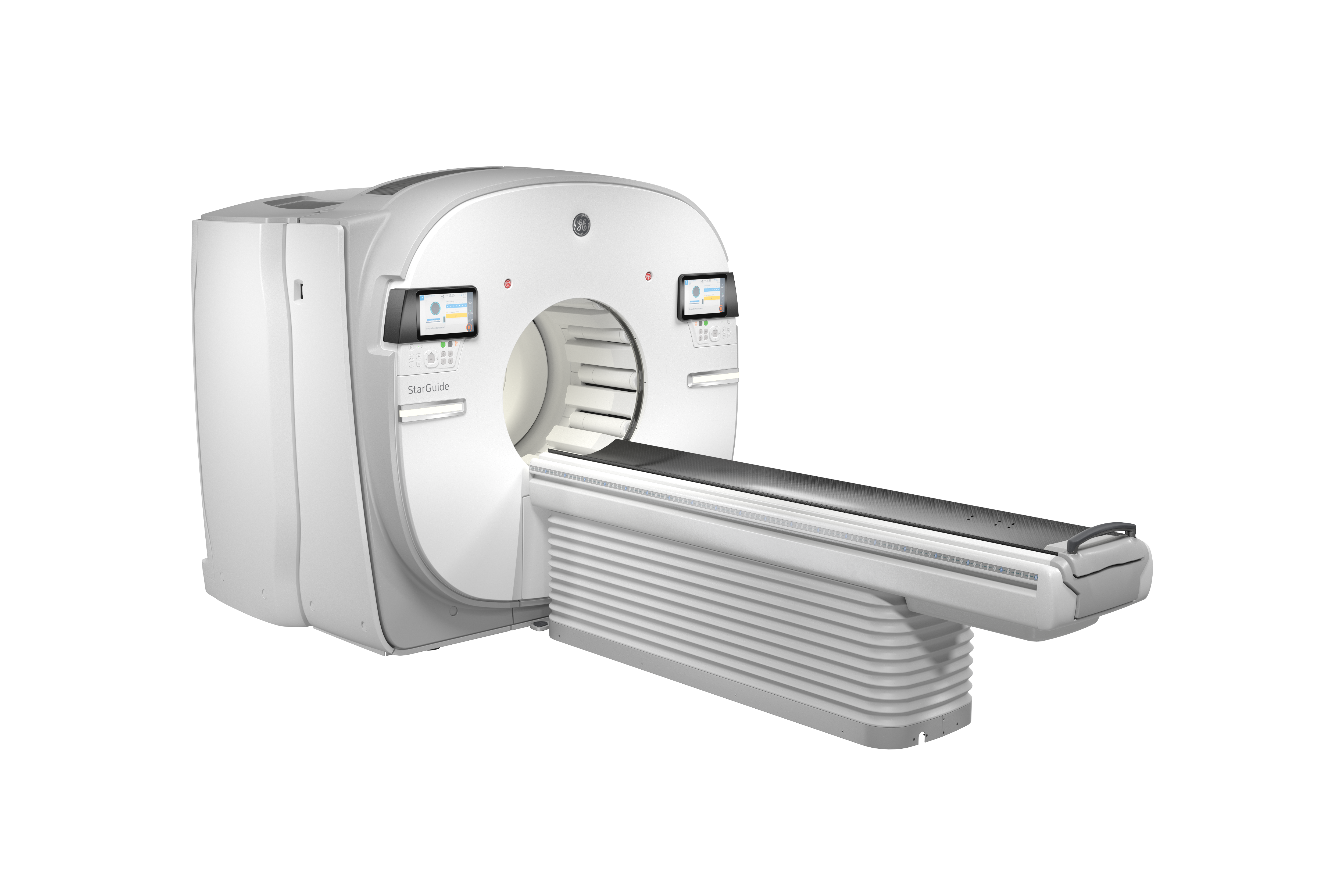New Nuclear Medicine System Designed to Advance Precision Health and Theranostics
 GE Healthcare has unveiled StarGuide, the company’s next-generation SPECT/CT system designed to help advance precision health and support greater theranostic capabilities in nuclear medicine. The next-generation system uses the latest digital technologies to help clinicians improve patient outcomes in bone procedures, cardiology, neurology, oncology, and other medical specialties. The system’s 12 Cadmium Zinc Telluride (CZT) Digital Focus Detectors scan patients in 3D to provide more information to clinicians and are also optimized for theranostic procedures, which combine the delivery of therapy to patients with diagnosis to monitor disease. StarGuide is CE marked and pending US FDA 510(k) clearance.
GE Healthcare has unveiled StarGuide, the company’s next-generation SPECT/CT system designed to help advance precision health and support greater theranostic capabilities in nuclear medicine. The next-generation system uses the latest digital technologies to help clinicians improve patient outcomes in bone procedures, cardiology, neurology, oncology, and other medical specialties. The system’s 12 Cadmium Zinc Telluride (CZT) Digital Focus Detectors scan patients in 3D to provide more information to clinicians and are also optimized for theranostic procedures, which combine the delivery of therapy to patients with diagnosis to monitor disease. StarGuide is CE marked and pending US FDA 510(k) clearance.
“COVID-19 and the events of 2020 highlighted the need for simple and fast workflows to allow clinicians and staff more time to care for patients, but it also highlighted the importance of listening to and rapidly responding to healthcare system and patient needs,” says Jean-Luc Procaccini, President & CEO, Molecular Imaging & Computed Tomography, GE Healthcare. “Today, healthcare systems continue to be asked to maximize efficiencies, without compromising patient care. In response, we designed our StarGuide SPECT/CT system to provide clinicians with the data they need to help them make personalized care decisions and treatment recommendations that are at the heart of precision health.”
For more than 20 years, SPECT/CT has proven to be a vital imaging tool used by clinicians to help diagnose and track the progression and regression of heart conditions, cancers, and other diseases. GE Healthcare has been at the forefront of this technology and the molecular imaging industry since introducing the first commercially available SPECT/CT scanner in 1999. Since then, SPECT/CT’s clinical use and diagnostic power have rapidly increased with the introduction of CZT detector technology, functional anatomical mapping, attenuation correction, flexible image reconstruction and dose reduction technologies.
“StarGuide represents a breakthrough in the world of SPECT,” says Matthieu Bailly, Head of Nuclear Medicine, Physician, Hospital of Orleans, France – the first global site for the StarGuide SPECT/CT system. “Thanks to the versatility of StarGuide’s shape adaptive gantry, we can narrow our field of view to focus on specific parts of the anatomy – such as the spine, heart or brain – to generate images with impressive detail not easily attained on conventional SPECT/CT systems. Using this technology, we are already redefining how we explore bone and cardiac assessments – and the ability to scan multiple isotopes at once is affording us opportunities to perform simultaneous imaging in a single session. We are just beginning to unlock the system’s potential.”
The ability to generate high-quality SPECT/CT images starts with StarGuide’s unique Optical Scout technology, which leverages the system’s efficiency-focused Swift Plan workflow to determine the contour of the patient body and set the rest of the clinical scanning procedure into motion. After processing the Optical Scout data, StarGuide’s detectors and table automatically position themselves for close proximity and contactless scanning of the patient. The slim Digital Focus Detectors then orbit the body as closely as possible, and from all necessary angles, to scan the target area — and not the air surrounding the patient. The result is high-resolution images for clinicians and minimization of time on the table for patients.
“StarGuide allows us to acquire the patient’s data in the best conditions,” explains Gilles Le Rouzic, Medical Physicist, Hospital of Orleans, France. “The pixelated CZT modules combined with registered Dual-Channel tungsten collimation also contribute to improved resolution and sensitivity compared to conventional SPECT/CT. Every test we’ve conducted thus far shows better results than a standard NaI camera. All in all, the shape adaptive gantry of this new device is innovative by its very nature.”
Before performing a SPECT/CT, a clinician administers very small amounts of radioactive materials (radiopharmaceuticals) which releases radioactive emissions that are detected by the CZT detectors and processed into images. Compared to conventional technologies, CZT detectors offer improved SPECT sensitivity and resolution of these emissions, which in turn helps clinicians pinpoint the size, shape, and position of lesions with exceptional accuracy. Paired with innovative reconstruction, the resulting images provide outstanding quantification for the diagnosis and staging of disease and monitoring of treatment.
Traditionally, only one tracer could be imaged at a time, but the excellent energy resolution of the GE Healthcare-produced CZT crystals for StarGuide’s Digital Focus Detectors offers clinicians the unique ability to simultaneously image multiple tracers in a single scan. This ability helps reduce the need for multiple patient visits and, in relevant cases, multiple patient sedations. Also, the inherent temporal registration between the images helps increase clinicians’ confidence in differential diagnosis.
Finally, the combination of StarGuide’s shape adaptive gantry and CZT detector technology supports the imaging of tracers used in theragnostic with impressive quality. This includes Lutetium-177 (177Lu), a tracer used to diagnose and evaluate a patient’s treatment response for neuroendocrine and prostate cancer. 177Lu is currently not an FDA-approved tracer.
While there is still much work to be done in the field of theragnostic and precision health, StarGuide offers clinicians unique opportunities to make personalized care decisions and treatment response assessments that are at the heart of theranostics. GE Healthcare is uniquely positioned to advance these efforts as the only partner with solutions spanning from pharmaceutical diagnostics, cyclotrons, chemistry synthesis, PET/CT, PET/MR, nuclear medicine, advanced digital solutions and pharma partnerships to cover the breadth of steps from discovery to diagnosis to treatment.